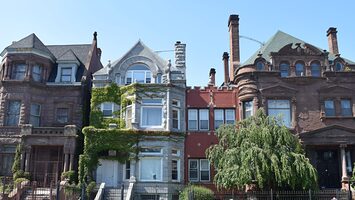The Black Community Legacy of Chicago’s Bronzeville Neighborhood
With the groundswell of new transplants to the area, Bronzeville became known for its vibrant dance halls and nightclubs, turning it into a destination for jazz, blues, and gospel musicians.

During the early to mid-twentieth century, a South Side Chicago neighborhood known as Bronzeville was the epicenter of black American culture and business. At its peak in 1950, more than 300,000 people lived in this vibrant, bustling district. A theater editor for the black newspaper Chicago Bee, James Gentry, suggested the name, noting that the skin color of many Black Americans is closer in hue to bronze than to black.
While the Harlem Renaissance remains better remembered for its cultural achievements, Chicago’s black aesthetic movement during this same period sparked its own arts revolution. Fueled by the Great Migration of southern blacks moving to northern cities, the “Chicago Black Renaissance,” as it was known, attracted waves of Black Americans to the city, igniting a flourishing urban culture in literature, music, and the visual and performing arts.
At the time, Chicago’s black population was concentrated around 22nd to 63rd streets between State Street and Cottage Grove. By the early 1930’s, the majority of Chicago’s black population lived in Bronzeville’s Grand Boulevard and Washington Park neighborhoods.
Bronzeville’s hub of activity flowed along 35th and State Street to 47th Street and South Parkway Boulevard (later renamed Martin Luther King, Jr. Drive). People came to socialize, dine and dance, shop, and conduct business. The crowds reflected a diverse mix of people, poor and wealthy, young and old, professional and blue collar.
With the groundswell of new transplants to the area, Bronzeville became known for its vibrant dance halls and nightclubs, turning it into a destination for jazz, blues, and gospel musicians.
Symbolic of this movement, the Regal Theater opened its doors in the 1920s. This opulently decorated venue, replete with plush carpeting and velvet drapes, hosted some of the most talented and prolific black entertainers in the nation, including Nat “King” Cole, Louis Armstrong, Ella Fitzgerald, Sarah Vaughan, Lena Horne, Dinah Washington, Miles Davis, Sammy Davis Jr., and Duke Ellington.
Bronzeville was also home to acclaimed black artists and intellectuals, including dancer Katherine Dunham, sociologist Horace Clayton, journalist and civil rights activist Ida b. Wells, author Richard Wright, and poet Gwendolyn Brooks. Wright’s influence was particularly notable. In 1936, he founded the South Side Writers Group to provide inspiration to up-and-coming black writers. The publication in 1940 of his book Native Son—a novel exploring a 20-year-old man’s dreams of escaping his impoverished Chicago neighborhood—catapulted Wright into national prominence.
In 1949, writer Gwendolyn Brooks appeared at the “Book Review and Lecture Forum,” a well-respected discussion group that focused on black literature and social issues. Brooks read from Annie Allen, her second book of poetry, at Bronzeville’s George Cleveland Hall Branch Library. The following year she became the first black writer to win the prestigious Pulitzer Prize, an achievement which symbolized the significant literary contributions of black Chicago during that era.
Bronzeville and Chicago’s South Side also built a reputation as the center of black journalism in the U.S. with the ascension of prominent black newspapers like the Chicago Defender, the Chicago edition of the Pittsburgh Courier, the Chicago Bee, and the Chicago Whip. These publications were supported by the national black news wire service, Associated Negro Press, which was led by Claude Barnett and headquartered in Chicago.
In examining Bronzeville’s fervent creativity, activism, and culture, Elizabeth Schroeder Schlabach, in her book Along the Streets of Bronzeville: Black Chicago’s Literary Landscape, notes:
“Bronzeville is the community that provided inspiration, training, and work for an entire generation of diversely talented Black American authors and artists who came of age during the years between the two world wars.”
Bronzeville saw a precipitous decline in the 50’s and 60’s with the end of racially restrictive housing that led to the out-migration of upper- and middle-class black families. Today, various community groups and business stakeholders have spawned an economic resurgence in Bronzeville aimed at reigniting this “city within a city,” turning it once again into a national epicenter of urban black creativity and free enterprise.